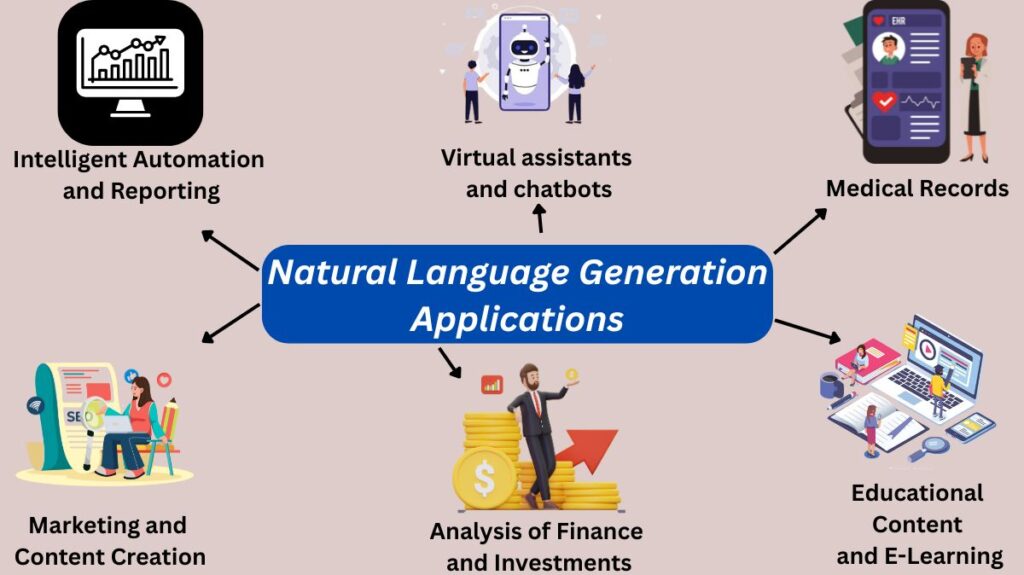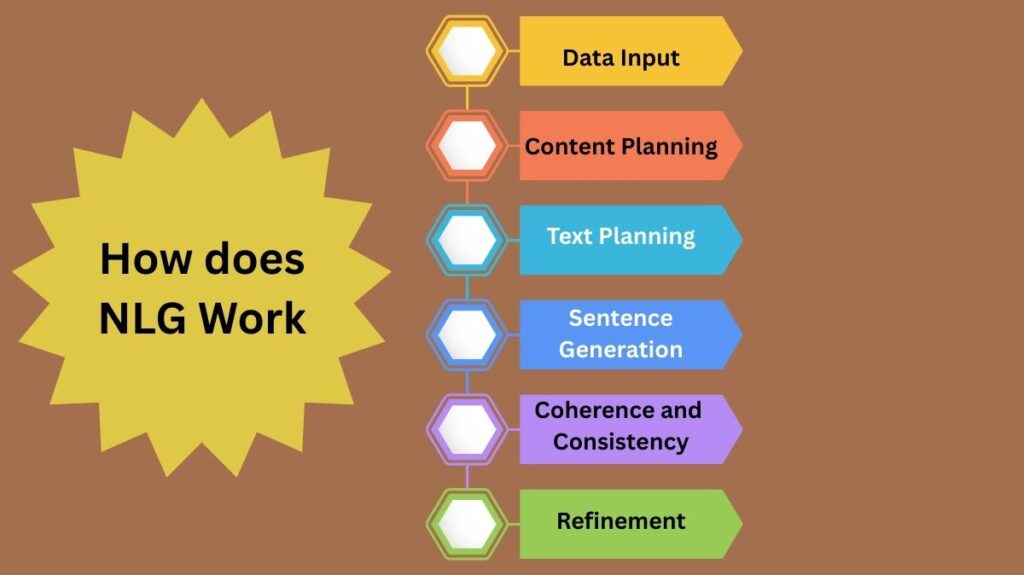Discover the most impactful Natural Language Generation Applications, from chatbots to automated reports and personalized content.
The act of translating computerized data into representations in natural language is known as Natural Language Generation (NLG). It focuses on producing text or speech output that is human-like using structured data or input from NLU systems. NLG essentially serves as a translator, taking computerized data and turning it into a human-readable format. This can include emails, summaries, stories, and data or information conversion into natural language prose.
NLG is one of the two primary elements of Natural Language Processing (NLP), together with Natural Language Understanding (NLU), according to the sources. NLG studies how computers can generate human language, whereas NLU studies how to make computers understand it. Additionally, the prior discussion history mentioned that NLU is typically regarded as more difficult than NLG. Natural language generation must take into account the starting point of the generation process, which can be more open-ended, whereas natural language analysis (NLU) deals with something known (surface text), according to one of the sources. Eventually, it might be beneficial to think of the beginning point of generation as the ultimate goal of work in natural language understanding.
Often, the generation process is broken down into multiple steps. According to one source, the utterance’s aims should be identified, plans for achieving those goals should be made, and the plans should be realized as a text. Another source divides it into:
- Texting (what to say) planning
- Sentence structure
- Text realization (the way to express it) Alternatively known as tactical generation or realization, this process entails translating meaning representations into strings, sometimes utilising the same vocabulary and grammar as a parser.
According to computational theory, the “generator” is a computer program that starts with the goal of communicating, chooses the material, organizes the rhetoric and language, fits it into a grammar, formats the text, or creates the prosody of speech. The ‘application’ or’speaker’ must have something to say, and the ‘generator’ must be able to translate these intentions into situation-appropriate, fluid writing.
History of Natural Language Generation
NLG has long been a component of computational linguistics, and in the 1980s it emerged as a significant subfield. A small part of machine translation in the 1950s and random sentence generators for grammar checkers in the 1960s were among the earliest uses. In the 1970s, motivated utterances began to be dynamically generated, including expert system explanations and database query responses.
In NLG, several methods and strategies are employed, such as:
- Template-based generation
- Rule-based generation
- Statistical methods In order to select between realizations created by an overgenerating language, recent work has focused on statistical generation utilizing n-grams.
- Generating using neural networks For applications like question answering, machine translation, text summarization, and conversational discourse, RNN-based language models are useful for text production. This falls under generative AI, a branch of artificial intelligence. In autoregressive generation, words are generated progressively by repeatedly sampling the subsequent word conditioned on past selections.
Natural Language Generation Applications
Natural language generation (NLG) has several industrial uses. The following fields employ NLG extensively:

Intelligent Automation and Reporting
Human-readable reports and summaries are produced using NLG from analytical and complex data. As a result, stakeholders find it particularly simple to understand and act upon business intelligence insights.
Marketing and Content Creation:
Content creation for blogs, websites, and advertising materials is done with NLG. Scalable production of written materials, such as product descriptions and promotional content, is within its capabilities.
Virtual assistants and chatbots:
NLG lets chatbots and virtual assistants answer in natural language, making them more conversational. Providing an engaging and human-like user experience is essential.
Analysis of Finance and Investments:
Financial reports, investment summaries, and market commentary are automatically generated in the finance business using natural language generation (NGL) and numerical data and trends.
Medical Records:
NLG is used to create patient summaries, medical reports, and documentation from electronic health records (EHR). It has the potential to streamline the documentation process in medical settings.
Educational Content and E-Learning
Learning resources, tests, and student-specific feedback are all developed with NLG’s assistance. It helps in the development of flexible learning technologies.
How does NLG Work
AI’s Natural Language Generation (NLG) field is concerned with automatically producing language that is similar to that of humans from data. When given structured data, NLG algorithms transform it into comprehensible, contextually relevant text that is easy for humans to read. Making the generated text sound like it was authored by a human is the aim.
An outline of the general operation of natural language generation is provided here:

- Data Input: NLG systems begin by using structured data. This data may come from databases, spreadsheets, and other structured formats, among other places.
- Content Planning: The system chooses which details to include in the output text after analyzing the input data. Decisions must be made on the basic structure, arrangement, and content selection.
- Text Planning: Once a decision has been made, the NLG system organizes the content’s natural language expression. It selects appropriate vocabulary, tone, and style for the generated text.
- Sentence Generation: The system creates individual sentences based on the anticipated content. This involves good word, phrase, and grammar choices. Natural language generation (NLG) systems use templates or machine learning.
- Coherence and Consistency: NLG systems should generate coherent and consistent text. Making sure the sentences that are generated flow organically and adhere to grammatical and stylistic rules is part of this. Additionally, it may mean continuing to create content that is consistent with previous efforts.
- Refinement: A refining method can be used to improve the quality of the generated text. Additional proofreading for grammar, naturalness, and clarity may be necessary for this.
Stages of NLG
- Content determination: Selecting the information to be mentioned in the text or the primary material to be expressed in a sentence. For example, choosing whether to specifically state that the pollen level in the southeast is 7 in the pollen example above.
- Document structuring: Choosing how to organize or structure the information that is being communicated is known as document structuring. For instance, choosing to describe the regions with high pollen concentrations first rather than the regions with low pollen concentrations.
- Aggregation: Combining related sentences to enhance comprehension and readability is known as aggregation. As an example, combining the two statements Friday grass pollen levels have risen from yesterday’s moderate to high levels, and they will be between 6 and 7 in the majority of the country within the single phrase. With readings of roughly 6 to 7 in most regions of the nation, grass pollen levels for Friday have risen from the moderate to high levels .
- Lexical choice: Lexical choice is the use of suitable words that make the meaning obvious. For instance, determining whether to describe a pollen level of 4 as medium or moderate.
- Referring expression generation: Generating referral expressions that aid in identifying a certain object or area is known as “referring expression generation.” For instance, choosing to designate a particular area of Scotland by using the Northern Isles and the far northeast of the mainland. Choosing pronouns and other forms of anaphora is another aspect of this endeavor.
- Realization: Writing and refining content that adheres to grammatical norms. For instance, the future tense of to be is used with will be.
Techniques for Evaluating NLG systems
- Task-based evaluation: Humans evaluate how well a tool aids a person in completing a task as part of task-based evaluation. For instance, a system that creates summaries of medical data can be tested by providing the summaries to physicians and determining whether or not the summaries aid in their decision-making.
- Human ratings: It evaluates the produced text by using a person’s ratings of the text’s quality and utility.
- Metrics: Professionally written texts are compared to produced texts.
NLG’s challenges
- Most people agree that NLG is more challenging than natural language comprehension or analysis.
- In contrast to analysis, which starts with the known text, a major issue is the absence of a clear and understandable beginning point or source representation.
- Because computers lack the nuanced depth of knowledge, perspective, and intention that people contribute to communication, it is difficult to generate really natural utterances.
- It is difficult to turn underlying facts into multi-sentential writings that are cohesive and fluid.
- Limited fluency and variety can occasionally result from linguistic realisation; stronger sentence planning tools are required.
- Certain techniques, such as copying the words from the input data, are needed to deal with terms that were not encountered during training (out-of-vocabulary words).
